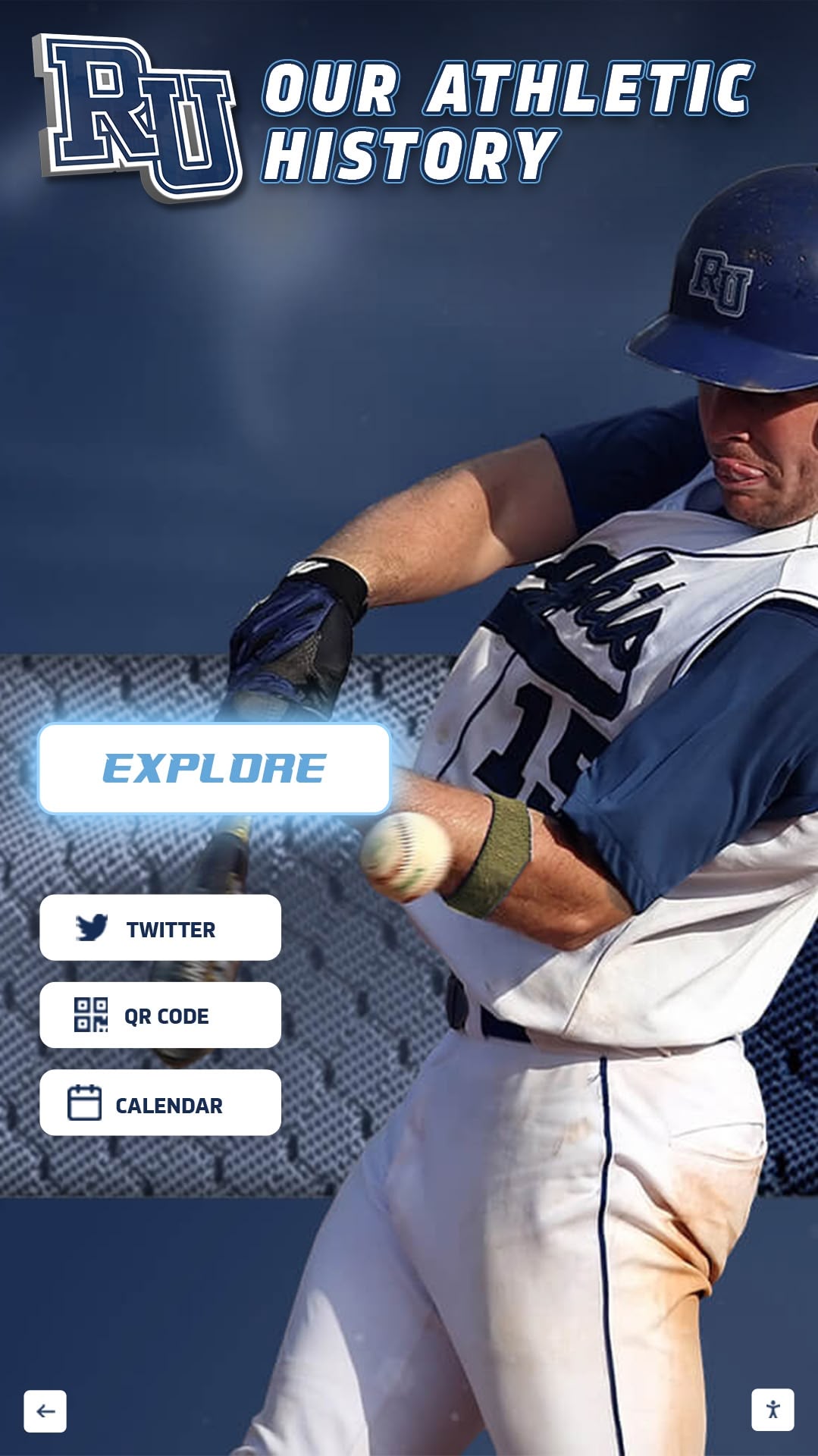Key Takeaways
Discover how to celebrate and showcase where your graduates went to play in college. Learn best practices for tracking, recognizing, and inspiring student-athletes through college placement displays.
Why Showcasing College Placements Matters
The decision to prominently recognize where graduates went to play in college extends far beyond simple celebration. These recognition systems create tangible impacts across multiple dimensions of athletic program success and school culture.
Inspiring Current Athletes to Dream Big
When ninth and tenth graders walk past displays showing upperclassmen who signed with college programs, the collegiate athletic pathway transforms from abstract possibility into achievable reality. Visible success stories prove that students from their school, competing in their programs, can reach the next level.
According to data from the NCAA, only approximately 7% of high school athletes continue competing at the college level across all divisions. This statistic makes each college commitment particularly noteworthy and worthy of celebration. When schools document these achievements comprehensively, they create inspirational roadmaps showing younger athletes exactly what dedication, performance, and development can accomplish.
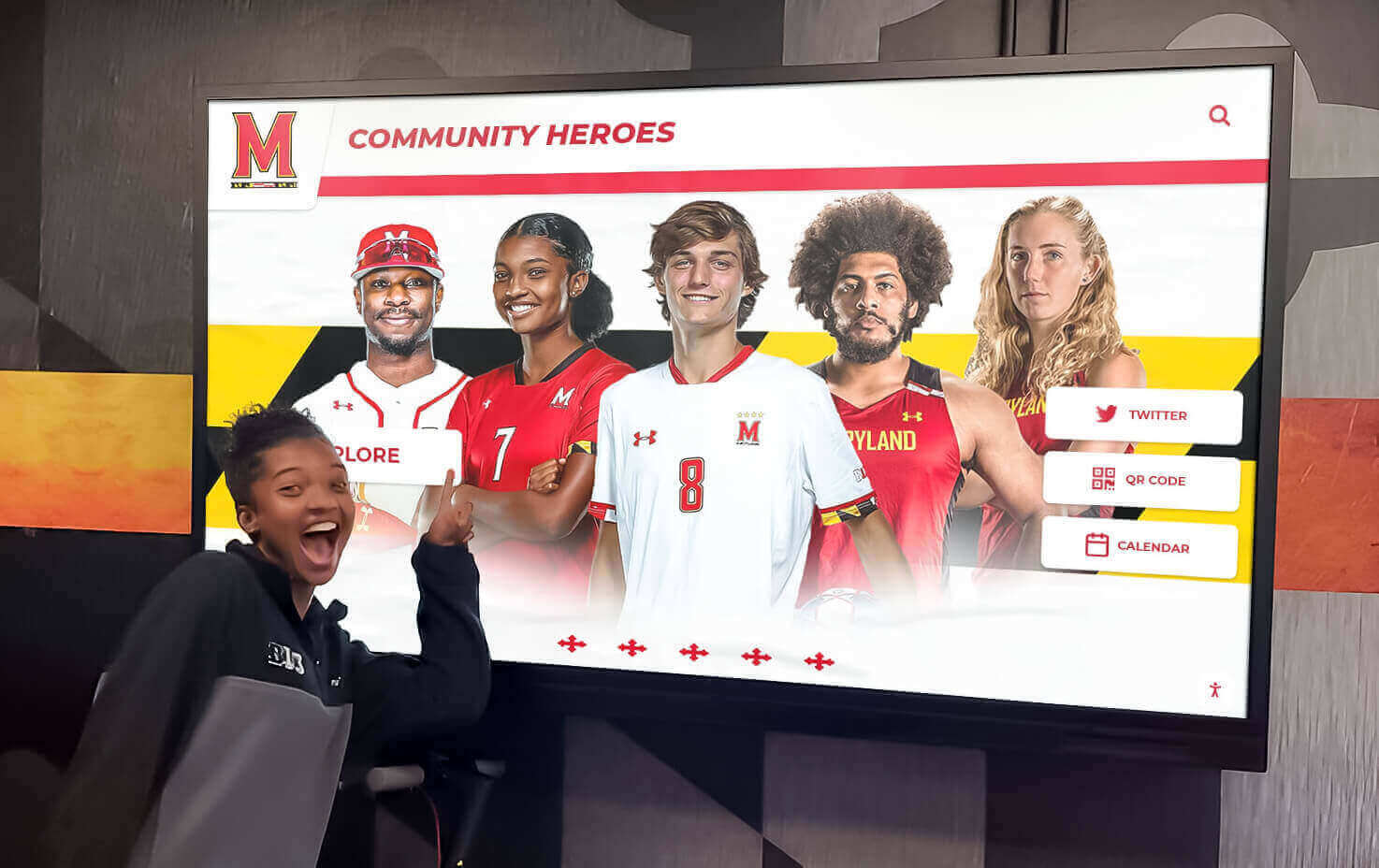
The psychological impact proves significant. Sports psychology research consistently demonstrates that visible role models from similar backgrounds create powerful motivational effects. When athletes see graduates from their own school succeeding at colleges—particularly schools matching their academic and athletic profiles—aspirations become concrete goals rather than distant fantasies.
Demonstrating Program Quality and Development
For prospective families evaluating high school options, college placement records provide objective evidence of program quality. Parents investing significant time and resources supporting youth athletics naturally seek programs with proven track records of developing college-ready athletes.
Comprehensive displays showing where graduates went to play in college serve as powerful recruiting tools. They document not just the quantity of college placements but the diversity—athletes signing with Division I powerhouses, competitive Division II programs, academically rigorous Division III schools, and NAIA institutions. This range demonstrates that programs develop athletes across multiple competitive and academic profiles.
Furthermore, these displays provide transparency about realistic outcomes. Families can see the actual colleges where recent graduates compete, assess whether these align with their own aspirations, and make informed decisions about program fit. This transparency builds trust and attracts families seeking genuine development rather than empty promises.
Building Community Pride and Support
Athletic success creates powerful community bonds. When local athletes achieve college commitments, entire communities celebrate these accomplishments as shared victories. Recognition displays amplify this pride by making achievements visible to all stakeholders—students, parents, alumni, faculty, and community members.
This visible celebration generates tangible benefits for athletic programs. Booster clubs see evidence of program success worthy of continued financial support. Alumni feel connected to current program achievements and remain engaged supporters. Local media cover signing days and commitments more extensively when schools actively promote these achievements. Community businesses sponsored by athletic departments appreciate association with successful, well-recognized programs.
For schools seeking to strengthen alumni engagement through recognition programs, showcasing where graduates went to play creates natural touchpoints connecting former athletes to current program success.
Creating Competitive Recruiting Advantages
In competitive athletic environments where multiple schools compete for talented middle school athletes, visible college placement success creates significant advantages. Families evaluating programs naturally gravitate toward those demonstrating track records of developing college-ready athletes.
When prospective families tour facilities and encounter comprehensive displays documenting where graduates went to play, several powerful impressions form:
Coaching Credibility: Coaches associated with extensive college placements gain credibility as developers of talent, not just collectors of naturally gifted athletes.
Program Infrastructure: The existence of sophisticated recognition systems signals institutional investment in athletics and commitment to celebrating achievement.
Realistic Pathways: Seeing graduates from various talent levels achieving college opportunities demonstrates inclusive development rather than focus solely on elite athletes.
Network Connections: Displays often include not just where athletes went but how they’re performing, creating evidence of ongoing relationships between high schools and college programs.
Programs implementing college recruitment strategies with digital recognition report measurable advantages in attracting ambitious families specifically seeking development-focused athletic environments.
Comprehensive Approaches to Tracking College Placements
Effective recognition begins with systematic tracking of where graduates went to play in college. Many programs struggle with incomplete records due to inconsistent data collection processes. Establishing robust tracking systems ensures no achievement goes unrecognized.
Creating Systematic Data Collection Processes
Senior Year Commitment Tracking: Designate specific staff—typically athletic directors or guidance counselors—responsible for tracking all senior athletic commitments as they occur. Create standardized forms athletes complete when making college decisions, capturing:
- Student-athlete name and graduation year
- Sport(s) committed for
- Position(s) played
- College name and location
- Division level (NCAA DI, DII, DIII, NAIA, NJCAA)
- Athletic conference
- Scholarship information (when publicly shared)
- Academic major or intended program
- Contact information for future updates
Post-Graduation Follow-Up: Many athletes make college athletic decisions after graduation, particularly those attending junior colleges before transferring. Establish annual outreach to recent graduates tracking:
- Athletes who enrolled at colleges and made teams as walk-ons
- Junior college athletes transferring to four-year programs
- Graduate transfer athletes continuing at new institutions
- Professional opportunities following college careers
Alumni Network Engagement: Leverage alumni associations and social media to maintain connections with graduates, tracking college athletic careers, academic achievements, and post-athletic career paths. This ongoing engagement provides rich content for recognition displays while strengthening alumni relationships.
Capturing Comprehensive Athlete Information
Beyond basic placement data, effective recognition tells complete stories about athlete journeys. Comprehensive profiles should include:
High School Career Highlights:
- Career statistics and achievements
- Championship participation and results
- Conference and state honors received
- Team captain or leadership roles
- Multi-sport participation and achievements
- Academic honors and GPA accomplishments
Development Narrative:
- How athletes progressed from freshman through senior years
- Challenges overcome and growth demonstrated
- Training commitment and work ethic examples
- Impact on team culture and younger athletes
- Character and leadership development
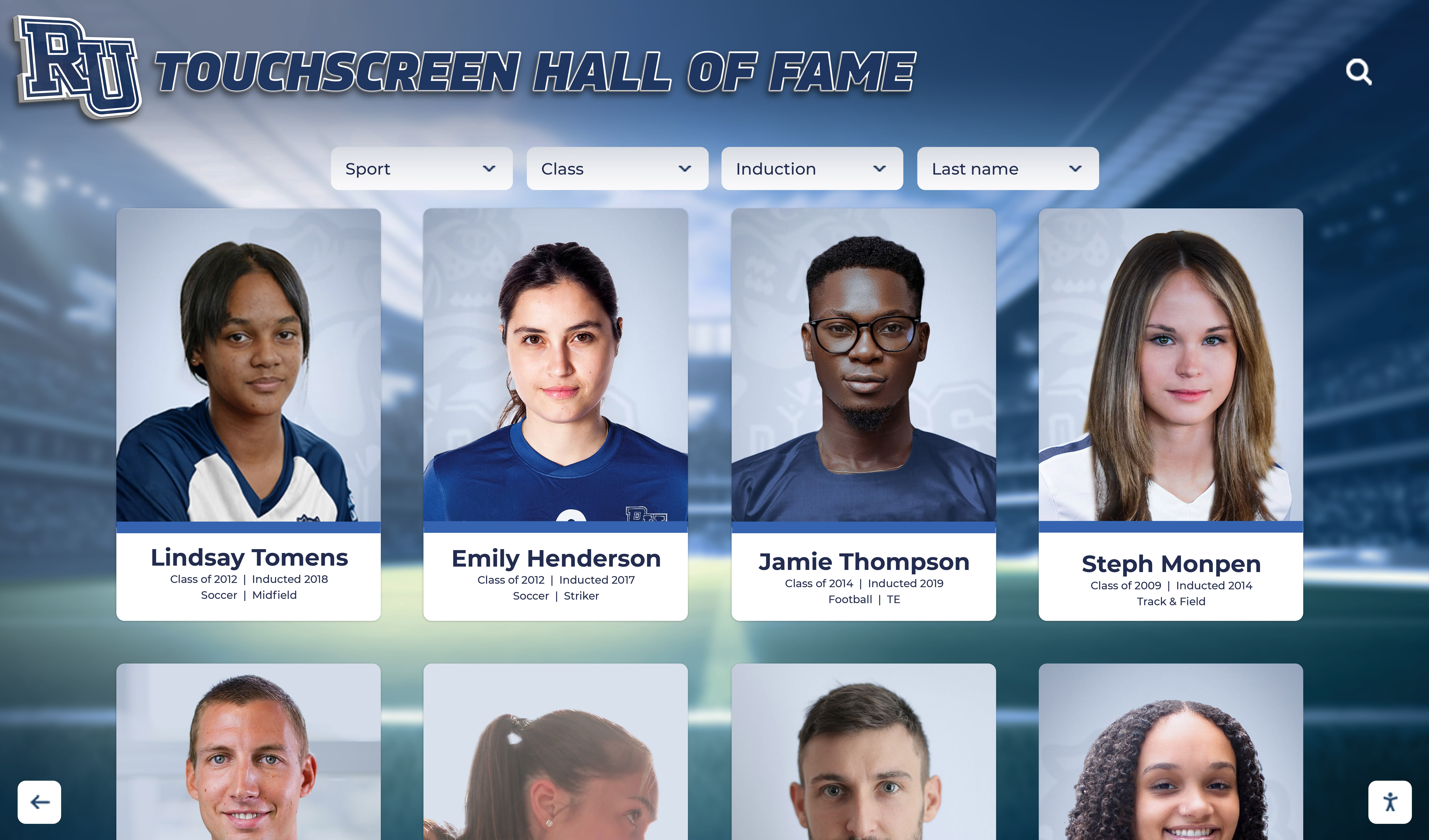
College Selection Process:
- What attracted athletes to chosen colleges
- Recruiting journey and decision factors
- Academic program alignment with career goals
- Advice for younger athletes pursuing similar paths
College Career Updates:
- Freshman year experiences and adjustments
- Playing time and statistical achievements
- Academic progress and major selection
- Post-graduation plans and career paths
This comprehensive information transforms simple lists of names and colleges into inspirational stories demonstrating complete athlete development pathways from high school through college and beyond.
Organizing Information for Maximum Impact
How schools organize college placement information significantly impacts usability and inspirational value. Consider multiple organizational approaches:
By Graduation Year: Chronological organization enables viewers to explore specific class years, comparing their accomplishments with current athletes or finding former teammates and classmates.
By Sport: Sport-specific organization helps current athletes find role models in their particular athletic disciplines, discovering typical college destinations for their sport and position.
By College: Organizing by destination institution reveals patterns—which colleges recruit most frequently from your program, creating potential relationship-building opportunities.
By Division Level: Categorizing by competitive level helps athletes understand realistic placement outcomes based on talent and academic profiles.
By Current Status: Highlighting currently competing college athletes, recent graduates, and program alumni creates different engagement opportunities with various timeframes.
Solutions like Rocket Alumni Solutions enable multiple simultaneous organizational approaches through searchable, filterable databases ensuring all stakeholders can explore information in ways most relevant to their interests.
Traditional Recognition Approaches
High schools have employed various traditional methods to showcase where graduates went to play in college, each offering distinct advantages and facing specific limitations.
Physical Display Options
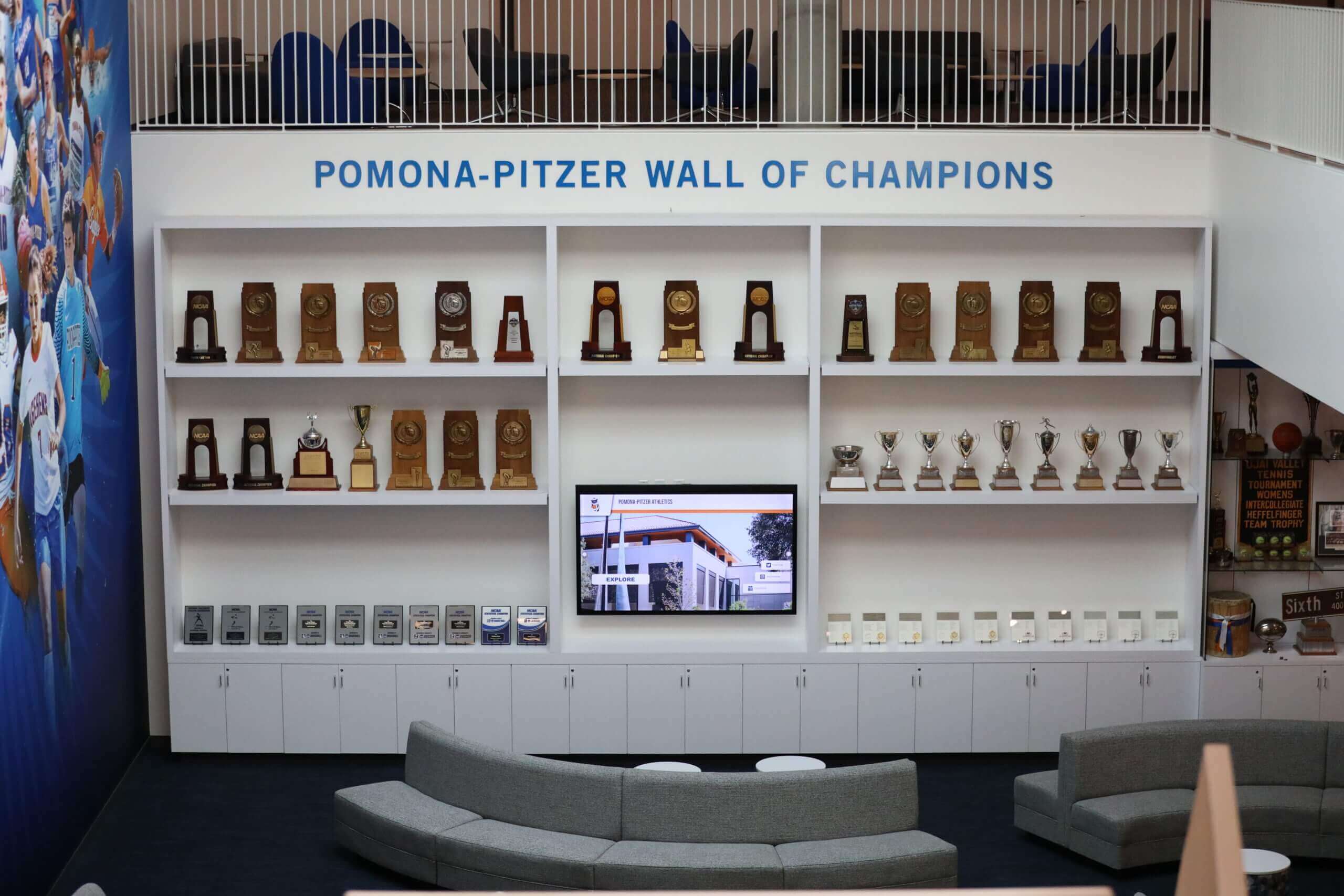
Plaque Walls: Individual plaques for each college athlete mounted on dedicated walls represent the most common traditional approach. These permanent installations create lasting tributes while facing space limitations as programs accumulate commitments over decades.
Banner Displays: Hanging banners featuring athlete photos, names, and college destinations work particularly well in gymnasiums and athletic facilities. These eye-catching displays celebrate recent commitments while requiring periodic rotation as space fills.
Photo Boards: Bulletin board-style displays featuring printed photos and information sheets offer budget-friendly flexibility. Schools can update these regularly, though they often appear less polished than permanent installations.
Trophy Case Integration: Incorporating college commitment recognition into existing trophy cases alongside championships and awards connects individual achievement with team success, though space constraints typically limit how many athletes can be featured.
Advantages of Traditional Methods
Traditional recognition approaches offer several benefits worth considering:
Permanence and Tradition: Physical plaques create tangible, lasting tributes that alumni can return to visit decades after graduation, connecting them to ongoing school traditions.
No Technology Requirements: Traditional displays require no software, internet connectivity, or technical expertise, eliminating potential technical complications.
Aesthetic Warmth: Well-designed physical displays can complement historic school architecture and create welcoming, traditional atmospheres that some communities prefer.
One-Time Costs: After initial installation, traditional displays require minimal ongoing expenses beyond occasional additions or maintenance.
Limitations Requiring Consideration
However, traditional approaches face significant constraints:
Space Limitations: Physical wall space is finite. Schools averaging 15-20 annual college athletes quickly exhaust available space, forcing difficult choices about which athletes to recognize or how long to maintain displays.
Update Challenges: Adding new commitments requires producing physical plaques or materials, scheduling installation work, and often engaging professional services. This process creates delays between commitments and recognition.
Limited Information Capacity: Space constraints limit how much information can be included. Traditional plaques typically show only names, sports, and colleges—missing opportunities to share development stories, statistics, or college career updates.
Maintenance and Deterioration: Physical materials deteriorate over time. Photos fade, plaques tarnish, and materials require eventual replacement, creating ongoing maintenance needs.
Static Presentation: Traditional displays cannot incorporate video highlights, interactive exploration, or dynamic content that resonates with digitally-native students.
For programs seeking to overcome these limitations while maintaining some traditional elements, digital trophy case solutions offer hybrid approaches combining physical and digital recognition.
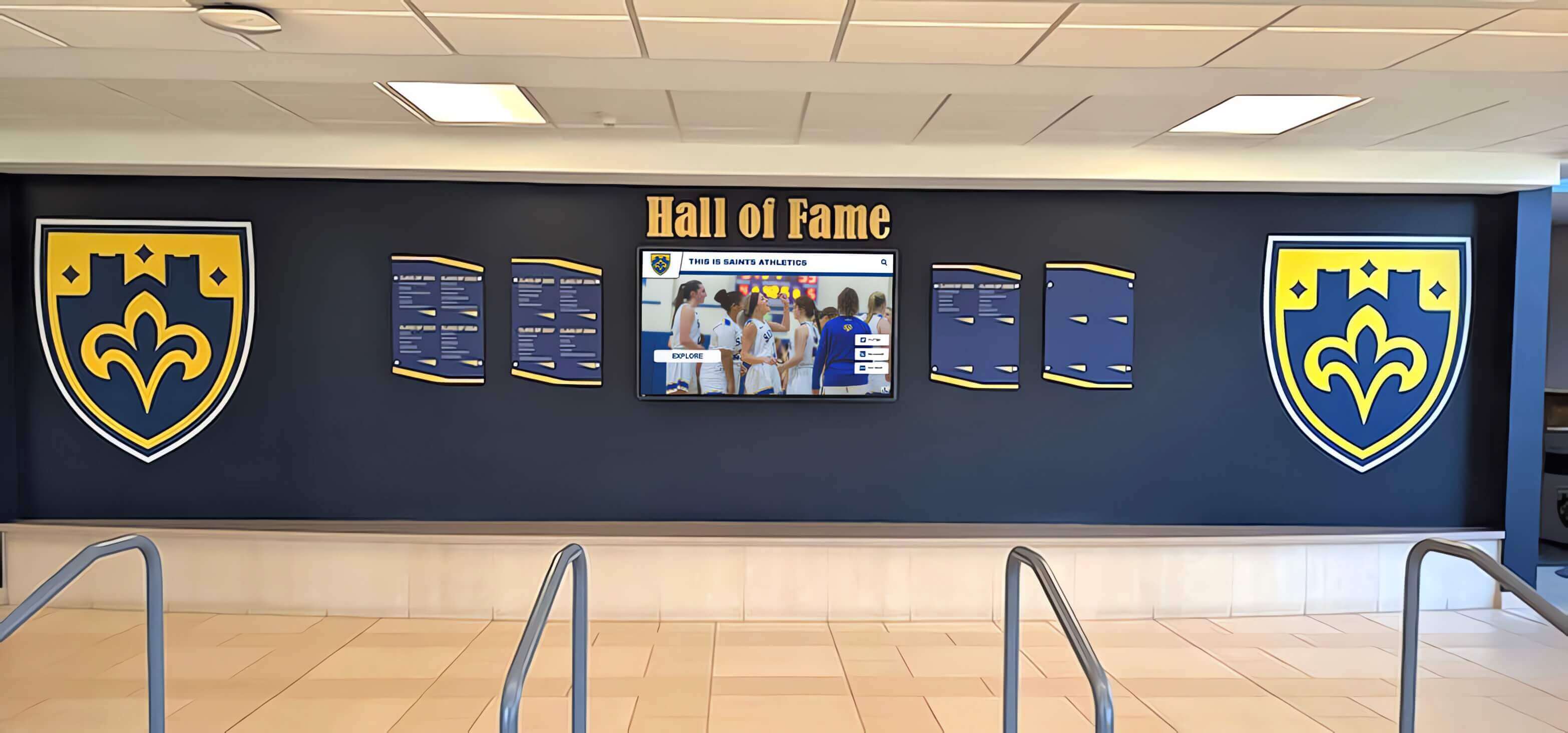
Modern Digital Recognition Solutions
Technological advancement has created powerful new possibilities for showcasing where graduates went to play in college, addressing traditional limitations while offering capabilities impossible with physical displays alone.
Interactive Touchscreen Displays
Standalone touchscreen kiosks provide engaging, interactive platforms where students, parents, and visitors actively explore college placement information through intuitive interfaces. These systems transform passive viewing into active discovery.
Search and Filter Capabilities: Users can instantly search for specific athletes by name, filter by sport or graduation year, explore all athletes attending particular colleges, compare statistics across different athletes, and discover athletes from specific positions or specialties.
Rich Multimedia Integration: Unlike static plaques limited to names and text, digital systems incorporate high-resolution athlete photos showing them in action, signing day ceremony photos with families and coaches, video highlight reels showcasing athletic ability, college commitment announcement videos, and interview footage discussing experiences and aspirations.
Unlimited Recognition Capacity: Digital platforms accommodate unlimited athlete profiles spanning decades without physical space constraints. Programs can recognize every college athlete across all sports and years without removing historical content as new athletes are added.
Real-Time Updates: New commitments can be added immediately after announcements without waiting for plaque production or physical installation. Programs can also update existing profiles as athletes progress through college careers, maintaining engagement with alumni achievements.
Schools implementing interactive touchscreen solutions for athletic recognition report significant increases in engagement time—visitors spending 10-15 minutes exploring content versus 30 seconds glancing at static displays—creating deeper connections and stronger inspirational impact.
Digital Signage Networks
Wall-mounted digital screens displaying rotating content provide dynamic alternatives to traditional photo boards. These systems work particularly well for:
High-Traffic Visibility: Screens positioned in main entrances, cafeterias, or athletic facility lobbies ensure broad visibility across student populations, staff, and visitors.
Rotating Content Showcases: Automated content rotation features different athletes throughout days and weeks, ensuring all college athletes receive featured recognition rather than being buried in alphabetical lists.
Event-Specific Content: During signing days, homecoming weeks, or alumni events, content can be customized to highlight relevant athletes or anniversaries.
Integration with Other Communications: The same screens can display other athletic announcements, upcoming event information, or general school communications when not showcasing college placements.
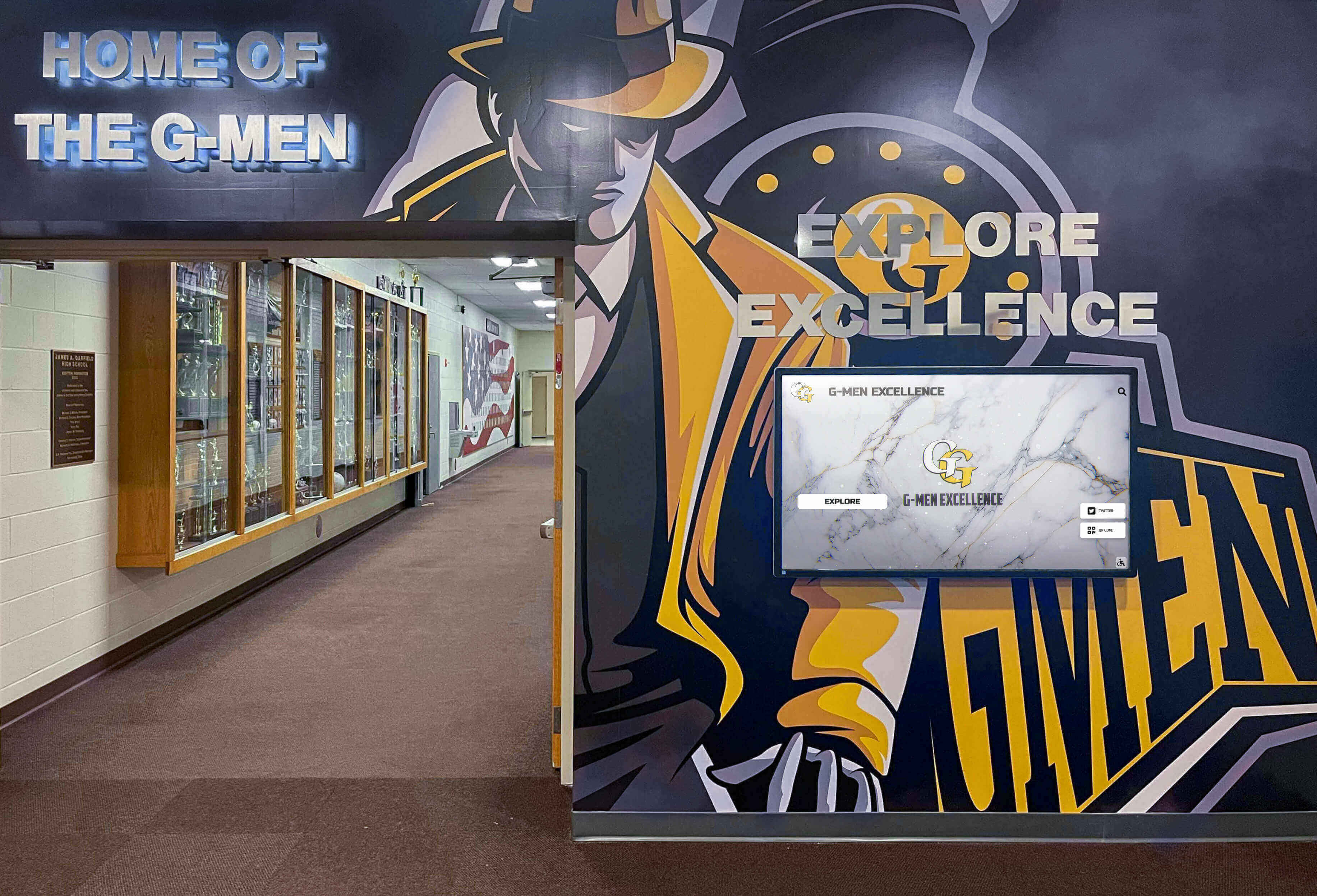
Hybrid Approaches Combining Traditional and Digital
Many successful programs implement hybrid strategies combining traditional and digital recognition, balancing respect for tradition with modern capabilities:
Historical Plaques with Digital Enhancement: Maintain existing plaque walls honoring historical athletes while adding digital displays for recent graduates and detailed information. This approach preserves tradition while embracing innovation.
Physical Displays with Digital Extensions: Use prominent physical displays in facilities while extending recognition through digital platforms accessible online, enabling alumni worldwide to explore content remotely.
Rotating Physical Highlights with Comprehensive Digital Archives: Feature recent commitments in physical displays while maintaining comprehensive historical databases in digital systems, ensuring current visibility while preserving complete records.
Key Features for Effective Digital Systems
When evaluating digital solutions for showcasing where graduates went to play in college, prioritize platforms offering:
User-Friendly Content Management: Cloud-based systems with intuitive interfaces enabling staff to add athletes, upload photos, and edit information without technical expertise or IT department involvement.
Mobile Responsiveness: Systems working seamlessly across touchscreen displays, desktop computers, tablets, and smartphones, ensuring consistent experiences whether viewing in person or online.
Customizable Design: Templates reflecting school colors, logos, and branding while maintaining professional presentation quality matching institutional standards.
Integration Capabilities: Ability to connect with school websites, social media platforms, and existing databases for streamlined content distribution across multiple channels.
Analytics and Insights: Usage tracking revealing which athletes receive most attention, peak viewing times, and content engagement patterns informing future development.
Rocket Alumni Solutions specializes in educational recognition with purpose-built platforms designed specifically for schools, offering templates, best practices, and support tailored to high school athletic programs showcasing college placement success.
Creating Compelling College Placement Content
Whether implementing traditional displays or digital systems, content quality significantly impacts recognition effectiveness and inspirational value. Compelling content transforms simple acknowledgment into powerful storytelling.
Writing Inspirational Athlete Profiles
Effective profiles extend beyond basic facts to tell authentic stories about athlete journeys:
Opening with Impact: Begin profiles with compelling hooks capturing what makes each athlete’s journey unique—significant obstacles overcome, exceptional improvement demonstrated, or distinctive character exemplified.
Development Narrative: Describe progression from freshman year through college commitment. Detail how athletes improved physically, technically, and mentally. Acknowledge challenges faced and overcome. Highlight dedication required to reach collegiate level.
Character and Leadership: Share examples of how athletes contributed beyond statistics—mentoring younger teammates, demonstrating resilience during difficulties, exhibiting sportsmanship and character, or serving as team captains and leaders.
Personal Voice: Include brief quotes from athletes about what drives them, what their commitment means to them personally, advice for younger athletes pursuing similar goals, or what they’re most excited about in their college athletic careers.
Future Aspirations: Share plans for college careers, academic goals, and long-term aspirations showing that athletic commitment integrates with broader life planning.
Gathering Rich Visual Assets
Visual content dramatically increases engagement and emotional impact:
Professional-Quality Photos: Invest in high-resolution images including action shots during competitions, team photos in uniforms, signing ceremony photos with families and coaches, formal portraits in school attire, and candid photos capturing personality.
Video Content (for Digital Displays): Capture video elements such as highlight reels showcasing athletic ability, commitment announcement videos, brief interviews discussing experiences, signing day ceremony footage, and messages to younger athletes or teammates.
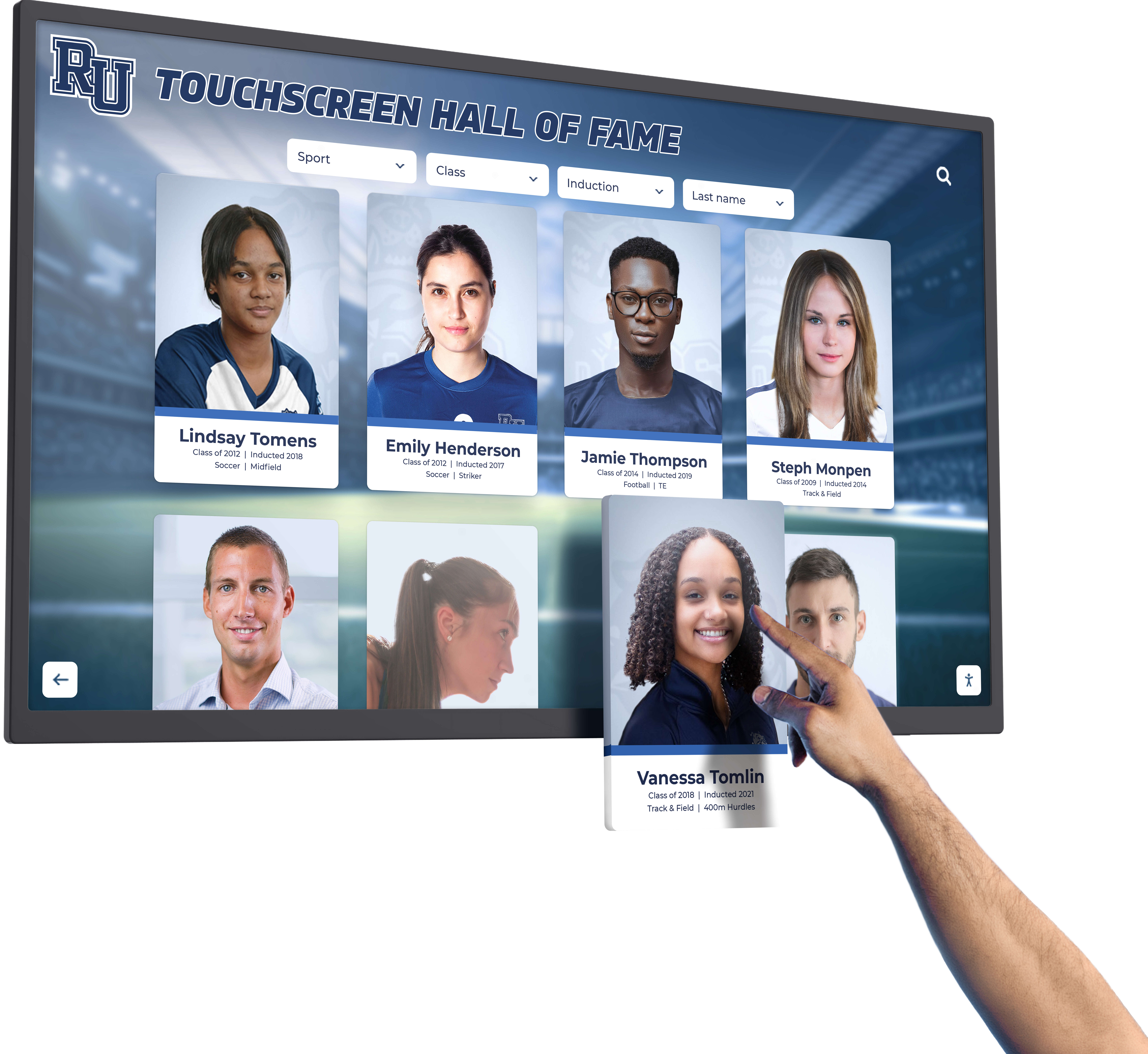
Consistent Visual Standards: Maintain quality through minimum resolution requirements (at least 1920 x 1080 pixels for digital displays), consistent lighting and backgrounds across photos, professional or high-quality smartphone photography, and appropriate, action-oriented imagery.
Structuring Information for Readability
Organize profile information logically:
Essential Information Section:
- Name and graduation year
- Sport(s) and position(s)
- College name, location, and division level
- Athletic conference
- Intended major or academic program
High School Career Highlights:
- Key statistics and achievements
- Championships and honors
- Years on varsity
- Other sports or activities
Personal Statement or Quote:
- Brief reflection on high school experience
- What this opportunity means
- Advice for younger athletes
College Career Updates (for digital systems):
- Current year and status
- Playing time and achievements
- Academic progress
- Post-graduation plans
This structured approach ensures readers can quickly find specific information while encouraging deeper exploration of complete stories.
Signing Day Celebrations and Recognition Events
National Signing Day events provide crucial opportunities to celebrate commitments publicly while gathering rich content for ongoing recognition throughout the year.
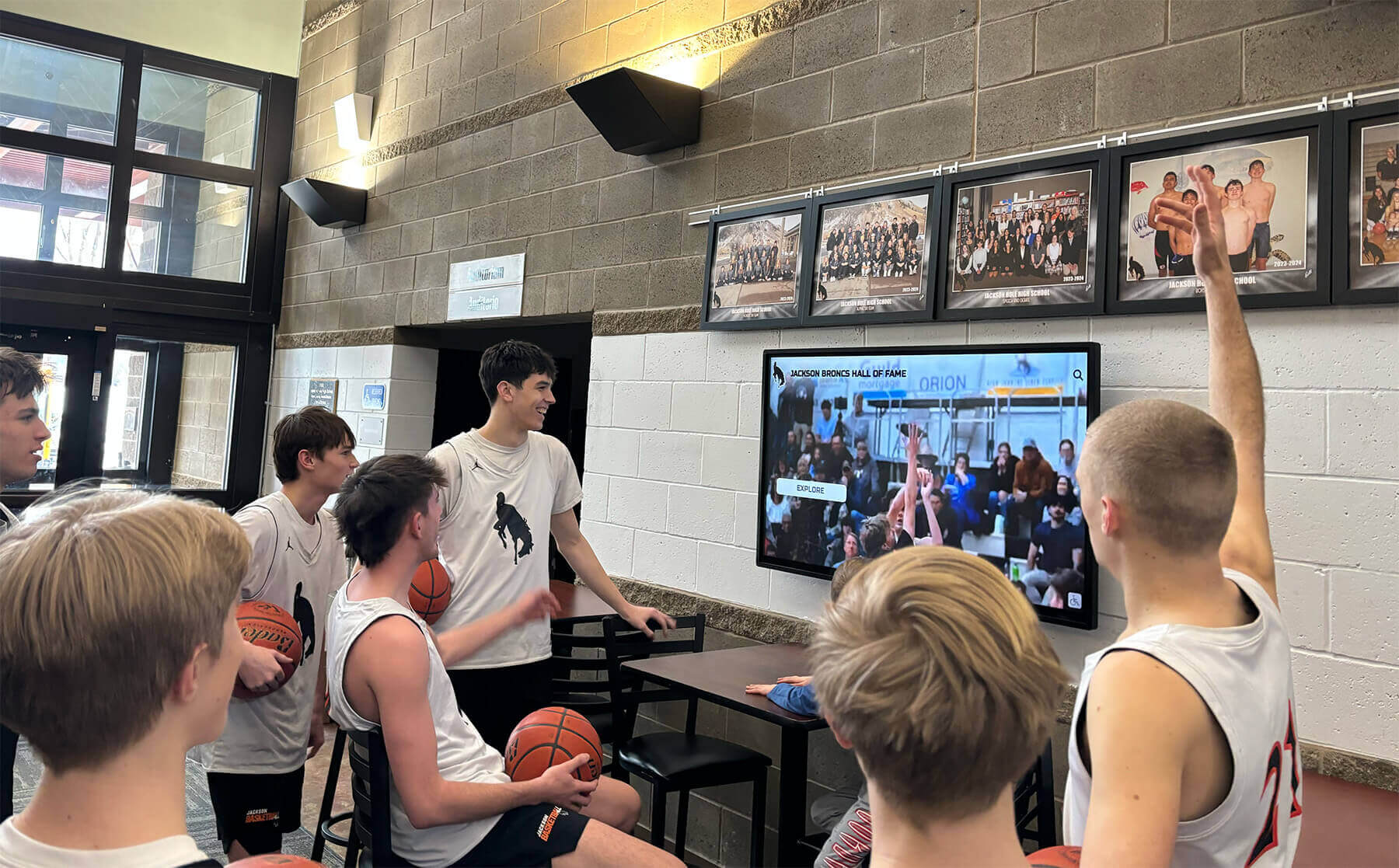
Understanding Signing Day Timelines
According to the NCAA, National Signing Day for most sports falls in November and February, creating natural celebration opportunities. However, the athletic landscape is evolving—the NCAA recently announced removal of the National Letter of Intent (NLI) Program, meaning student-athletes will now sign athletic grants-in-aid directly with colleges.
Fall Signing Period (November): Early signing period for football and women’s basketball, providing the first major celebration opportunity of the academic year. This period typically sees the highest media attention and community interest.
Spring National Signing Day (February): Final signing period for most other sports, often generating the largest ceremonies with athletes from multiple programs signing together—baseball, softball, soccer, lacrosse, and many others.
Year-Round Recognition: Many athletes make commitments outside major signing periods, particularly those signing with Division III schools (which don’t participate in formal signing days) or junior colleges. Establish processes for celebrating all commitments regardless of timing.
Organizing Meaningful Signing Ceremonies
Effective ceremonies balance formal recognition with authentic celebration:
Professional Setup and Atmosphere: Create photo-worthy settings with designated signing tables featuring college pennants and gear, professional backdrops with school branding, space for family and supporter seating, and media areas for photography and video.
Structured Program Flow: Organize ceremonies with welcome remarks from athletic directors or principals, individual athlete recognition with coach introductions, brief athlete statements thanking supporters and discussing choices, photo opportunities with families, coaches, and teammates, and closing remarks celebrating collective achievements.
Family Involvement: Recognize parents, siblings, and key supporters acknowledging the community effort behind athletic achievement and creating meaningful family memories.
Media Coverage and Documentation: Coordinate local media attendance, live-stream ceremonies for extended family and supporters, capture professional photography and video, and plan social media coverage extending recognition reach beyond physical attendees.
For schools looking to maximize the impact of these events, college signing celebrations with digital displays provide frameworks for integrating recognition events with ongoing display systems.
Integrating with School Traditions
Connect signing recognition to existing traditions maximizing visibility:
Homecoming Recognition: Feature current year signings during homecoming events, create special displays during homecoming week, and facilitate alumni athlete meet-and-greet opportunities.
Senior Night Celebrations: Honor all senior athletes during senior night while providing special recognition for those continuing careers, ensuring every senior feels valued regardless of college commitment status.
Athletic Award Ceremonies: Include signing recognition in year-end banquets through special categories, video montages, and commemorative items celebrating achievements alongside other athletic honors.
Alumni Weekend Programming: During alumni reunions, showcase where recent graduates went to play while featuring successful alumni athletes, creating multigenerational connections around athletic excellence.
Strategic Placement for Maximum Visibility
Where schools position college placement recognition significantly impacts how many people encounter displays and the impressions these encounters create.
High-Traffic Location Selection
Main Entrance Areas: Position recognition where visitors first enter buildings. This placement creates immediate positive impressions and establishes athletic achievement visibility before people proceed deeper into facilities. Prospective families touring schools encounter this evidence of program quality during critical decision-making processes.
Athletic Facility Entrances: Lobbies and hallways leading to gymnasiums, weight rooms, or athletic offices represent natural locations where athletes, families, and visitors regularly pass. Athletes see these displays daily, creating constant inspiration and reinforcement.
Cafeteria and Common Areas: Spaces where students gather daily ensure broad visibility across entire student bodies, not just those involved in athletics. This inclusion builds school-wide pride and awareness of athletic achievements.
Gymnasium and Arena Visibility: Displays visible from spectator seating during games and competitions enable ongoing recognition when athletic communities gather. This placement reinforces program quality messages to visiting competitors and recruits.
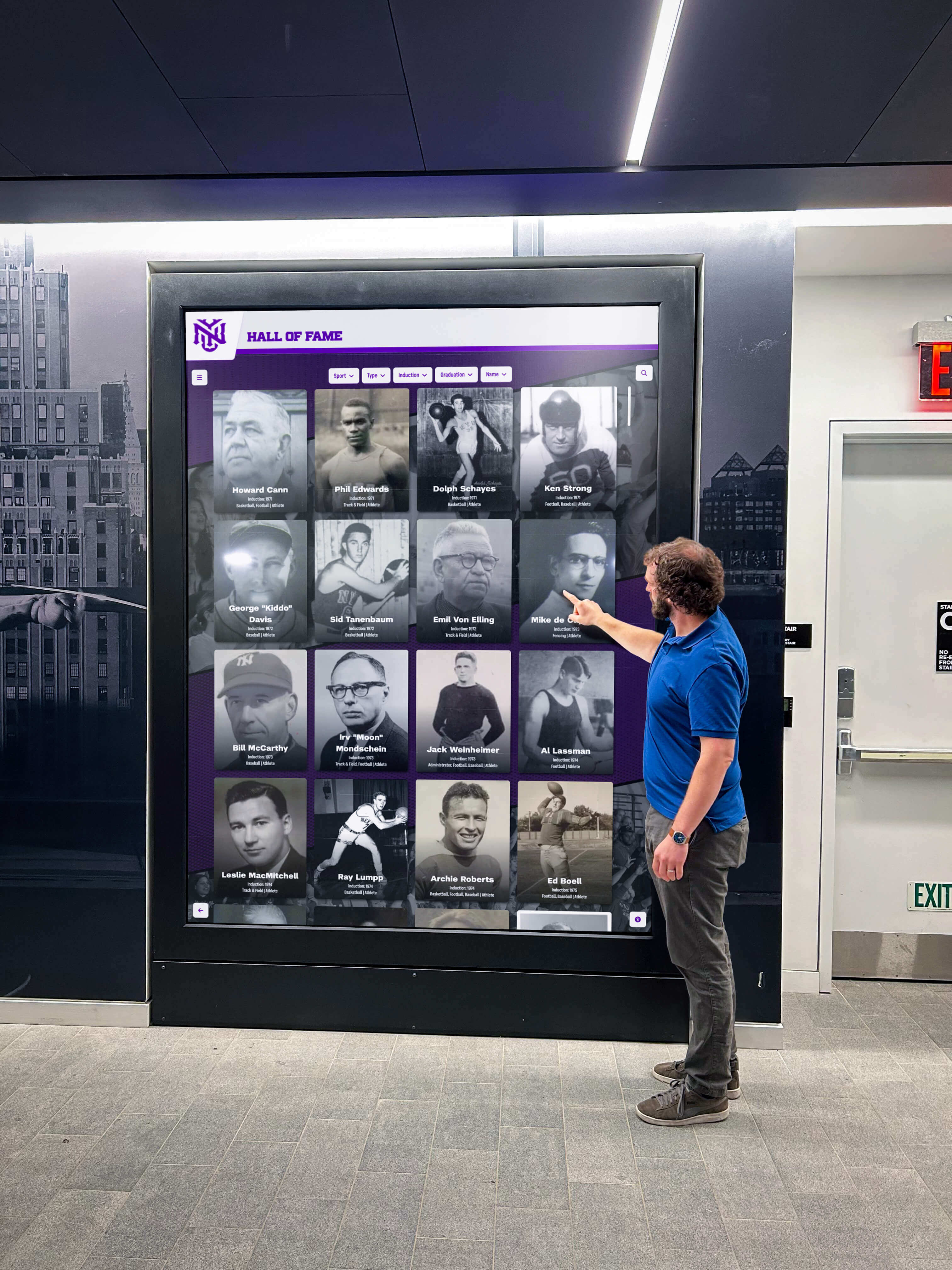
Considerations for Different School Contexts
Large Schools with Extensive Placements: Programs with 20, 30, or 50+ annual commits require systems capable of handling high volume without overwhelming viewers. Digital displays excel through search, filtering, and organized navigation features preventing information overload.
Small Schools with Limited Placements: Schools with only a few annual signings deserve equally impressive recognition through comprehensive, detailed profiles and prominent placement ensuring these significant achievements receive appropriate celebration demonstrating that every college commitment matters.
Multi-Sport Balance: Ensure recognition systems provide equitable visibility across all sports—not just high-profile programs like football and basketball. Every college athletic commitment represents extraordinary achievement deserving equal celebration regardless of sport popularity.
Multi-Location Strategies: Consider implementing recognition at multiple campus locations—main entrance for general visibility, athletic facilities for athlete inspiration, and guidance office areas where academic planning occurs, reinforcing that athletic and academic paths integrate.
For schools planning comprehensive athletic facility improvements, college placement recognition should be prioritized as both inspirational infrastructure and recruiting tool.
Budget Considerations and Implementation Approaches
High schools evaluating options for showcasing where graduates went to play in college need realistic budget expectations and understanding of various implementation approaches at different price points.
Traditional Display Cost Ranges
Basic Bulletin Board Approach: $200-$500 for materials including frames, mounting supplies, and printing. This entry-level option works for schools with limited budgets and only a few annual commitments. Annual updates require minimal additional investment.
Professional Plaque Systems: $50-$150 per athlete for custom plaques, plus installation costs. Schools with 15-20 annual signings face $750-$3,000 yearly expenses. Over 10 years, this approach accumulates $7,500-$30,000 in costs.
Custom Wall Installations: Comprehensive traditional displays with built-in lighting, custom cabinetry, and professional design range from $5,000-$15,000 for initial installation, plus ongoing plaque costs for new athletes.
Digital Display Investment
Entry-Level Digital Signage: Basic digital screens with simple content management start around $2,000-$4,000 per display, suitable for rotating slideshow presentations. These systems offer limited interactivity but provide dynamic content capabilities traditional displays lack.
Interactive Touchscreen Systems: Professional touchscreen kiosks with comprehensive software range from $8,000-$20,000 depending on screen size, enclosure quality, and software capabilities. These systems provide engaging exploration experiences with unlimited capacity.
Comprehensive Recognition Platforms: Full-featured systems combining physical displays, cloud software, mobile access, and ongoing support typically range from $15,000-$35,000 for initial implementation. While requiring higher initial investment, these systems often achieve cost neutrality within 5-7 years by eliminating recurring plaque costs while providing superior capabilities.
Ongoing Costs: Budget $1,000-$3,000 annually for software subscriptions, content management support, and display maintenance. These predictable costs enable accurate long-term financial planning.
Funding Strategies
Schools can pursue multiple funding approaches:
Athletic Booster Clubs: Booster organizations often prioritize recognition programs demonstrating program success and inspiring continued excellence. College placement recognition creates visible returns on booster investments in athletic programs.
Sponsorship Opportunities: Local businesses may sponsor recognition sections in exchange for visibility, particularly businesses owned by alumni or community members. Appropriate sponsorship recognition can offset significant implementation costs.
Capital Campaign Inclusion: Larger recognition projects can be incorporated into facility improvement campaigns, especially when tied to athletic facility renovations or school building projects.
Alumni Donation Drives: Alumni who benefited from athletic programs may be willing to fund recognition systems ensuring current athletes receive similar celebration. Targeted outreach to successful alumni athletes often generates enthusiastic support.
Phased Implementation: Start with basic systems covering recent graduates and expand capabilities over time as funding becomes available and value is demonstrated. This approach manages upfront costs while showing stakeholders tangible benefits justifying additional investment.
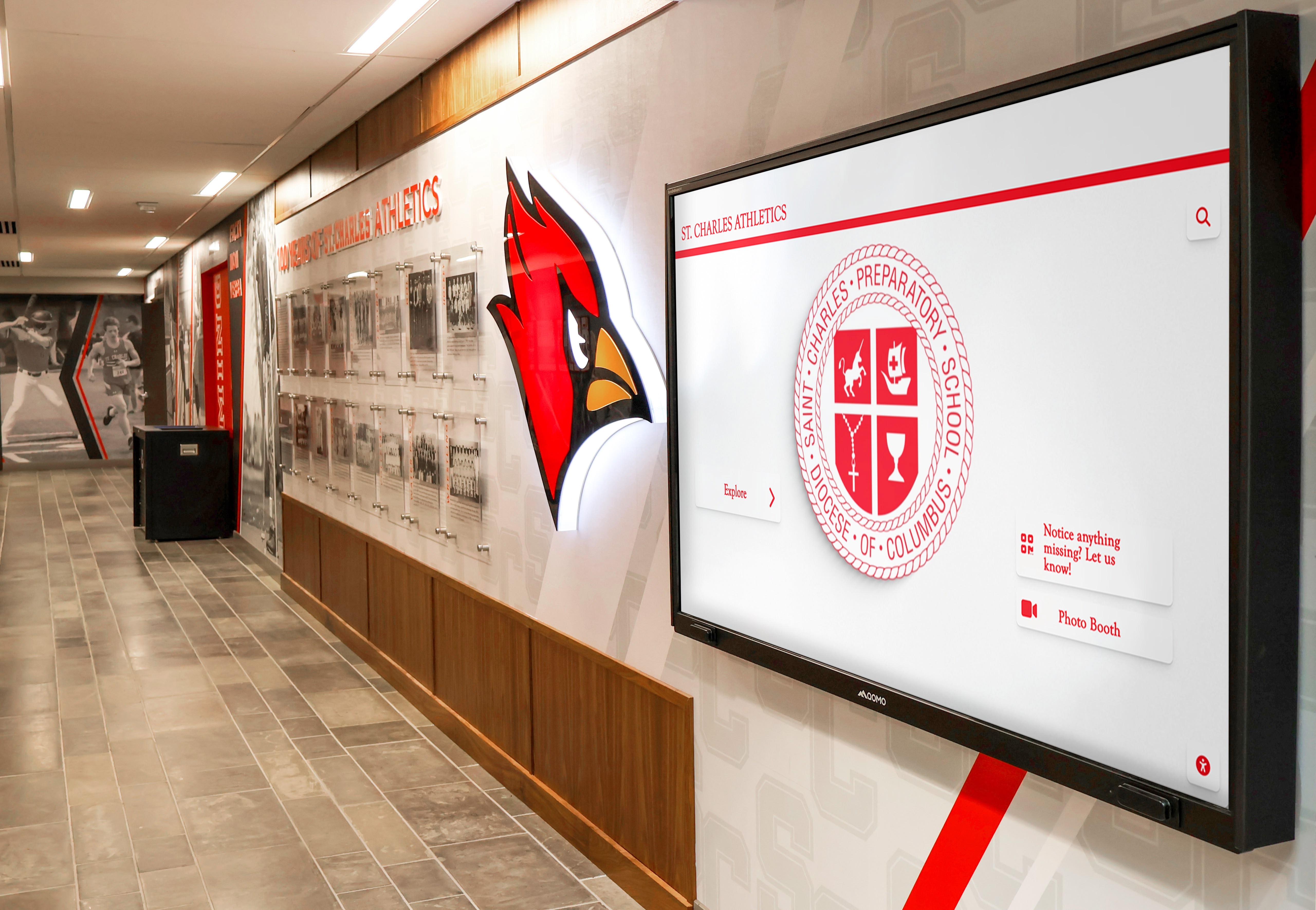
Best Practices for Sustainable Recognition Programs
Long-term success requires systematic planning addressing content management, maintenance, and continuous improvement ensuring recognition systems remain valuable years after initial implementation.
Establishing Administrative Workflows
Clear Responsibility Assignment: Designate specific staff members responsible for different recognition elements:
- Primary administrator overseeing overall program strategy
- Sport-specific contacts submitting athlete information from each team
- Content coordinator creating profiles and managing updates
- Technical administrator handling display maintenance (for digital systems)
- Photography coordinator capturing signing day and athlete images
Standardized Information Collection: Create forms athletes and coaches complete when commitments occur, including all profile elements, photo submission requirements, and permission forms for media use. Standard processes ensure consistency and completeness.
Timeline Standards: Establish expectations for how quickly new signings are added after announcements—ideally within 24-48 hours for digital systems or within 1-2 weeks for traditional displays. Timely recognition maintains relevance and demonstrates responsiveness.
Annual Review Cycles: Schedule regular reviews updating college career progress for alumni, removing outdated information or transitioning to historical archives, gathering feedback from stakeholders about system effectiveness, and identifying improvement opportunities.
Content Quality Standards
Photography Guidelines: Maintain consistent quality through minimum resolution standards (1920 x 1080 pixels for digital displays), professional or high-quality smartphone photos, appropriate backgrounds and lighting, and friendly, professional presentation showing athletes in positive contexts.
Writing Consistency: Develop style guides ensuring similar tone, length, and structure across all athlete profiles. This creates professional, unified presentation regardless of who writes individual profiles. Include templates and examples helping different staff members maintain standards.
Accuracy Verification: Cross-reference all statistics, colleges, conference affiliations, and other details before publication. Errors in recognition displays can embarrass athletes and damage program credibility. Implement review processes catching mistakes before public display.
Inclusive Language: Use language celebrating diverse paths to college athletics—from Division I scholarships to Division III academic opportunities to junior college pathways. Avoid implying that certain divisions or colleges are more worthy of celebration than others.
Privacy and Permission Management
Media Release Policies: Implement clear policies addressing general media release forms during athletic program participation, specific permission for signing wall publication, rights to review content before publication, opt-out mechanisms for privacy-concerned families, and post-graduation policies for profile retention.
Sensitive Information Protocols: Be conservative with information like specific scholarship amounts (unless publicly disclosed by families), financial aid or need-based assistance details, home addresses or direct contact information, and medical history or injury information.
Social Media Integration Considerations: If systems enable social media sharing, implement appropriate privacy controls ensuring personal information isn’t inadvertently distributed beyond intended audiences.
Measuring Impact and Demonstrating Value
Evaluate recognition system effectiveness through both quantitative metrics and qualitative feedback, understanding program value and identifying improvement opportunities justifying continued investment.
Engagement Metrics
For digital recognition systems, track:
- Daily interaction counts and viewing sessions
- Average time spent exploring content
- Most-viewed athlete profiles revealing popular content
- Search queries showing user interests and information needs
- Peak usage times and seasonal patterns informing content strategy
- Geographic data (when available) showing remote access by alumni
Comparative Benchmarks: Compare engagement before and after system implementation, demonstrating value added by new recognition approaches versus traditional displays.
Community Feedback Collection
Gather input systematically from multiple stakeholder groups:
Athlete and Family Perspectives: Survey signing athletes about recognition experience adequacy, profile accuracy and completeness, pride and satisfaction with representation, and suggestions for program improvement. This direct feedback ensures recognition meets its primary beneficiaries’ expectations.
Younger Athlete Input: Assess inspirational impact through conversations with underclassmen about whether recognition influences their goals and motivation, awareness of college athletic opportunities in their sports, and knowledge of pathways alumni followed to college levels. This feedback measures achievement of inspirational objectives.
Coach Perspectives: Collect coach observations about recognition program impact on recruiting competitive position, team culture and motivation effects, program reputation in communities and among peer programs, and utility during facility tours with prospective athletes and families.
Visitor and Alumni Comments: Note feedback from campus visitors, prospective families, and alumni about recognition system impressions, ease of finding specific information, and overall effectiveness compared to systems at other schools.
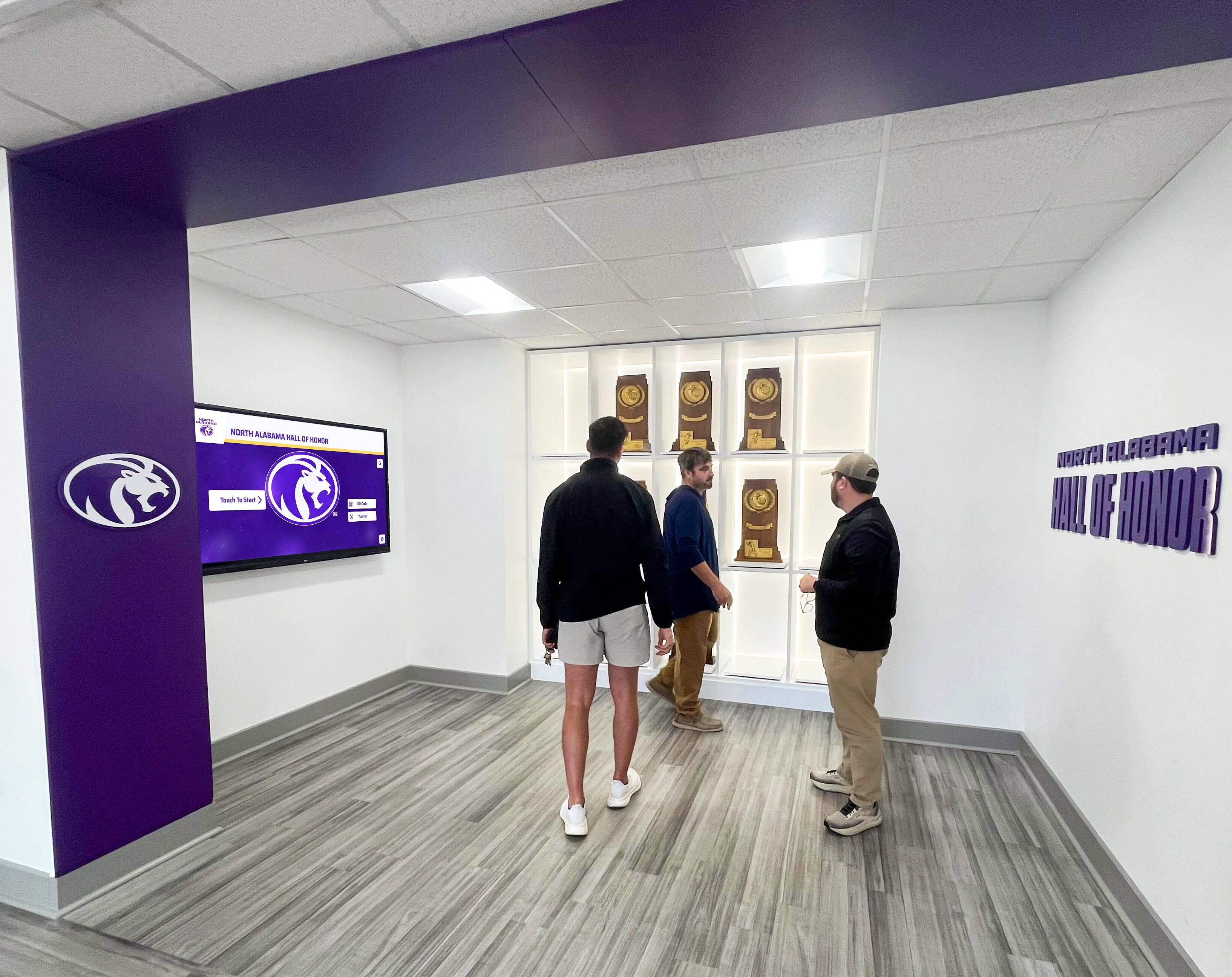
Program Impact Indicators
Beyond direct metrics, observe broader program impacts:
- Changes in youth athlete participation in feeder programs suggesting improved program reputation
- Increased interest in athletic programs during school choice and enrollment decisions
- Enhanced local media coverage of athletic program achievements and commitments
- Improved alumni engagement and financial giving to athletic programs
- College coach feedback about program reputation and recruiting territory visibility
For schools seeking to demonstrate return on investment for recognition systems, measuring engagement and ROI from digital displays provides frameworks and methodologies.
Connecting to Broader Recognition Programs
College placement recognition works most effectively as a component of comprehensive athletic recognition strategies rather than standalone initiatives. Integration with other recognition efforts amplifies impact while creating cohesive celebration of diverse achievements.
Integration with Hall of Fame Programs
Many schools integrate college placement recognition with broader athletic hall of fame initiatives celebrating multiple achievement categories:
Athletic Hall of Fame: Induct exceptional alumni athletes based on college athletic success, professional careers, or lifetime contributions to school athletics. College placement displays create natural pathways showing which inducted hall of famers continued careers at college levels.
Coaching Recognition: Honor coaches who developed successful programs and mentored athletes to college opportunities. Connecting coach recognition with athlete placement success demonstrates coaching impact objectively.
Team Championships: Commemorate championship teams through group photos, rosters, and season highlights alongside individual athlete recognition. Show how championship teams often produce multiple college athletes.
Record Performance Boards: Document school records in each sport, celebrating athletes who achieved extraordinary statistical or competitive milestones. Connect record holders with their college destinations showing correlation between elite performance and college opportunities.
Celebrating Academic-Athletic Balance
Well-rounded recognition programs celebrate achievements beyond athletics demonstrating institutional commitment to holistic development:
Scholar-Athlete Recognition: Prominently feature athletes achieving high GPAs alongside athletic excellence. Include information about academic scholarships and honors programs at destination colleges showing that athletic and academic excellence integrate rather than compete.
Academic All-Conference Selections: Celebrate conference academic honors demonstrating that successful college-bound athletes excel in classrooms as well as competition venues.
Major and Career Information: Include intended majors, academic programs, and career aspirations in athlete profiles reinforcing that college athletic opportunities represent educational pathways, not just competitive extensions.
For programs seeking to strengthen these connections, resources on balancing academic and athletic recognition provide implementation guidance.
Supporting Positive School Culture
Effective recognition systems showing where graduates went to play in college contribute to positive overall school culture by demonstrating institutional investment in student success across all domains, creating visible examples of achievement inspiring students in all activities, building pride across entire school communities beyond just athletic departments, attracting ambitious families seeking schools celebrating excellence comprehensively, and creating gathering points where students, staff, and families connect over shared institutional pride.
This broader cultural impact justifies recognition investment as school-wide benefit rather than athletics-only expense.
Future Trends in College Placement Recognition
Looking ahead, several emerging trends will shape how schools recognize where graduates went to play in college.
Enhanced Digital Capabilities
Augmented Reality Features: Future systems may overlay digital content onto physical spaces, enabling smartphone users to access expanded information by pointing cameras at traditional displays, creating hybrid experiences combining physical tradition with digital depth.
Direct Alumni Updates: Social media-style platforms may enable athletes to update their own profiles with college career achievements, creating dynamic recognition evolving as alumni progress without requiring school staff to maintain every update manually.
Video Messaging: Athletes may record personalized video messages for younger teammates or prospective students, creating mentorship connections through recognition platforms that extend beyond simple information sharing to relationship building.
AI-Powered Content Generation: Artificial intelligence may assist in drafting athlete profiles from submitted information, creating first drafts staff can refine rather than starting from blank pages, improving efficiency without sacrificing personal touch.
Data-Driven Insights
Advanced analytics may enable:
- Tracking which college placement profiles inspire most younger athlete engagement, informing content development priorities
- Correlating recognition system visibility with youth program participation trends and program growth
- Identifying which colleges recruit most frequently from programs, enabling strategic relationship development
- Understanding demographic patterns in college athletic placement, informing equitable development efforts
Expanded Recognition Scope
Future programs may broaden beyond traditional college athletics to include:
- Club sport participation at colleges for athletes continuing competition in non-varsity contexts
- Athletic training and sports medicine academic programs for athletes pursuing sports careers in different roles
- Esports college teams and competitive gaming representing emerging competitive opportunities
- International athletic opportunities abroad for graduates competing internationally
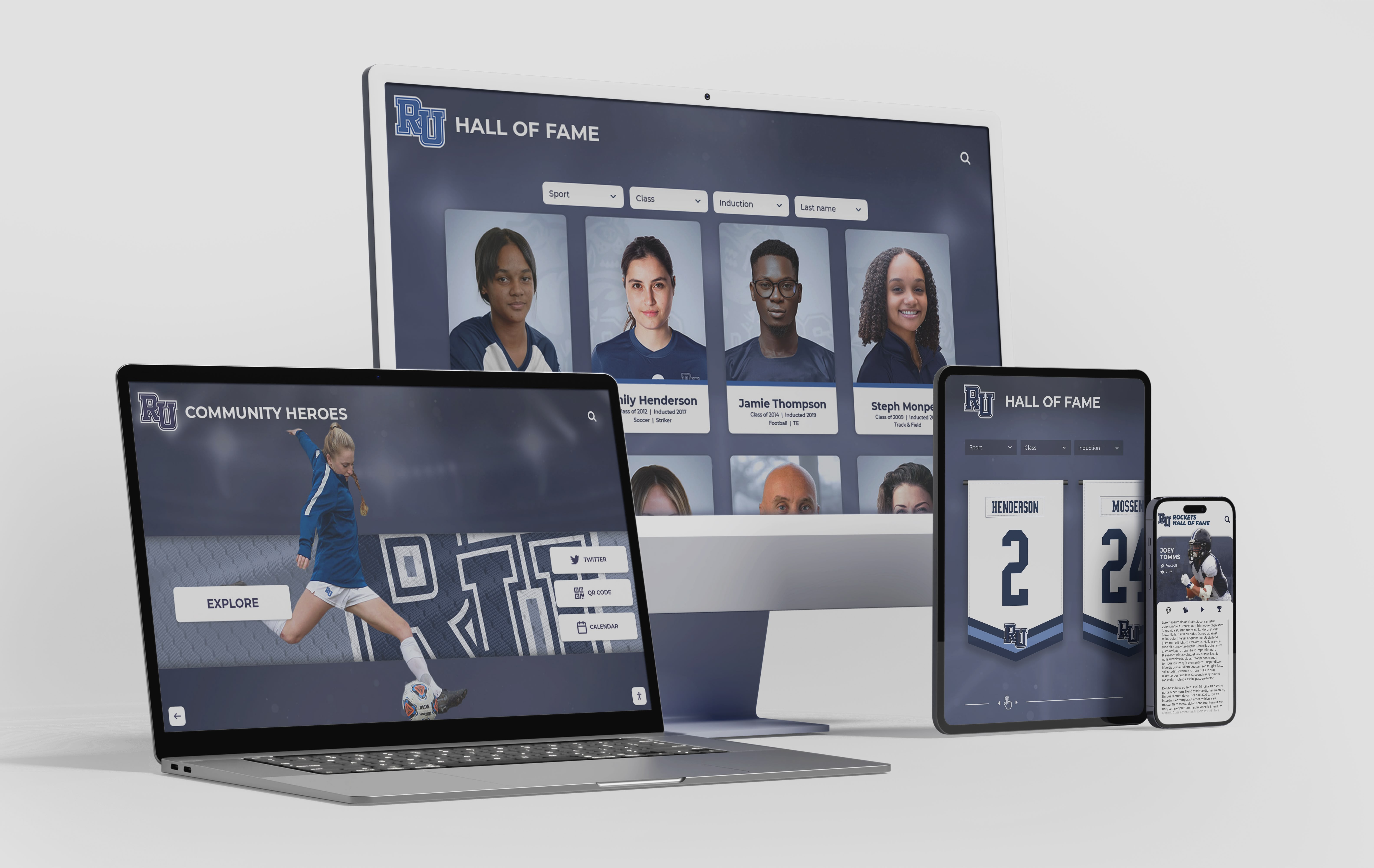
Getting Started: Implementation Roadmap
For high schools ready to implement or upgrade systems showcasing where graduates went to play in college, follow this strategic roadmap ensuring successful implementation and sustainable operation.
Phase 1: Assessment and Planning (2-3 months)
Needs Evaluation: Assess current recognition gaps and deficiencies, typical annual signing numbers and historical totals, available budget and potential funding sources, physical space options and visibility locations, and staff capacity for ongoing management and content creation.
Stakeholder Input: Gather perspectives from athletic directors about program priorities, coaches about athlete information availability, administrators about budget and approval processes, current athletes and parents about desired features, and alumni about their experiences and suggestions.
Research Options: Explore traditional display contractors and pricing, digital display vendors and platform capabilities, comprehensive recognition platforms with full-service support, and examples from peer schools facing similar contexts.
Goal Setting: Establish clear objectives such as how many years of historical athletes to include initially, what information to capture for each athlete, how frequently to update and maintain content, and what success looks like in terms of engagement and impact.
Phase 2: Vendor Selection and Design (1-2 months)
Vendor Evaluation: For digital systems, assess providers based on educational sector experience and references, platform capabilities and user interface quality, implementation support and training services, ongoing service quality and responsiveness, and total cost of ownership including all ongoing expenses.
Design Customization: Work with selected vendors to customize displays reflecting school colors, branding, and logos, athletic program identity and traditions, preferred information organization and navigation, and aesthetic integration with existing facilities.
Content Planning: Develop information templates ensuring comprehensive, consistent athlete profiles, style guides maintaining writing quality and tone, information collection forms and workflows, and initial content strategies prioritizing recent graduates before expanding to historical athletes.
Phase 3: Implementation and Launch (2-3 months)
Hardware Installation: Complete necessary electrical work and power supply, network connectivity for digital systems, display mounting and enclosure installation, and final positioning and visibility optimization.
Content Development: Create initial athlete profiles for recent graduates, gather photos, videos, and other media assets, organize information for optimal navigation and discovery, and prepare featured content for launch promotion.
Soft Launch and Testing: Begin displaying recognition with initial content, monitor for technical issues or usability problems, gather early feedback from users and stakeholders, and refine based on observations before official celebration.
Official Launch Celebration: Host launch event during signing day, homecoming, or other high-visibility occasion, generate media coverage highlighting new recognition capabilities, communicate availability to entire community, and celebrate this enhanced recognition capability.
Phase 4: Ongoing Management and Optimization
Regular Content Updates: Add new signings promptly after commitments, update profiles with college career achievements periodically, maintain photo and information quality standards, and refresh featured content regularly to maintain interest.
Community Engagement: Promote recognition system through school communications regularly, encourage athlete and family interaction and feedback, share content via social media extending reach, and gather ongoing input for improvement opportunities.
Program Assessment: Review engagement metrics and usage patterns quarterly, assess impact on program culture and recruiting outcomes, identify enhancement opportunities and new features, and plan expansions or upgrades when beneficial.
Conclusion: Celebrating Success, Inspiring Excellence
Showcasing where graduates went to play in college represents far more than simple acknowledgment of athletic commitments. When implemented thoughtfully with comprehensive content, prominent visibility, and sustainable management, these recognition programs honor extraordinary individual achievement through permanent celebration, inspire younger athletes by demonstrating achievable pathways, demonstrate program quality objectively to prospective families, build community pride through visible athletic excellence, strengthen alumni connections to current program success, and create recruiting advantages in competitive environments.
Whether implementing traditional plaque walls, modern digital touchscreen systems, or hybrid approaches combining both, the keys to success remain consistent: comprehensive content telling complete athlete stories beyond basic facts, prominent placement ensuring maximum visibility to key audiences, systematic management maintaining quality and currency, integration with broader school culture and recognition programs, and genuine celebration of diverse achievements across all sports and competitive levels.
As you develop or enhance your school’s approach to celebrating college placements, remember that you’re not simply posting names and colleges—you’re creating inspirational environments where dreams become tangible realities, excellence receives appropriate recognition, and every student-athlete’s journey to the next level is honored with the dignity and permanence it deserves.
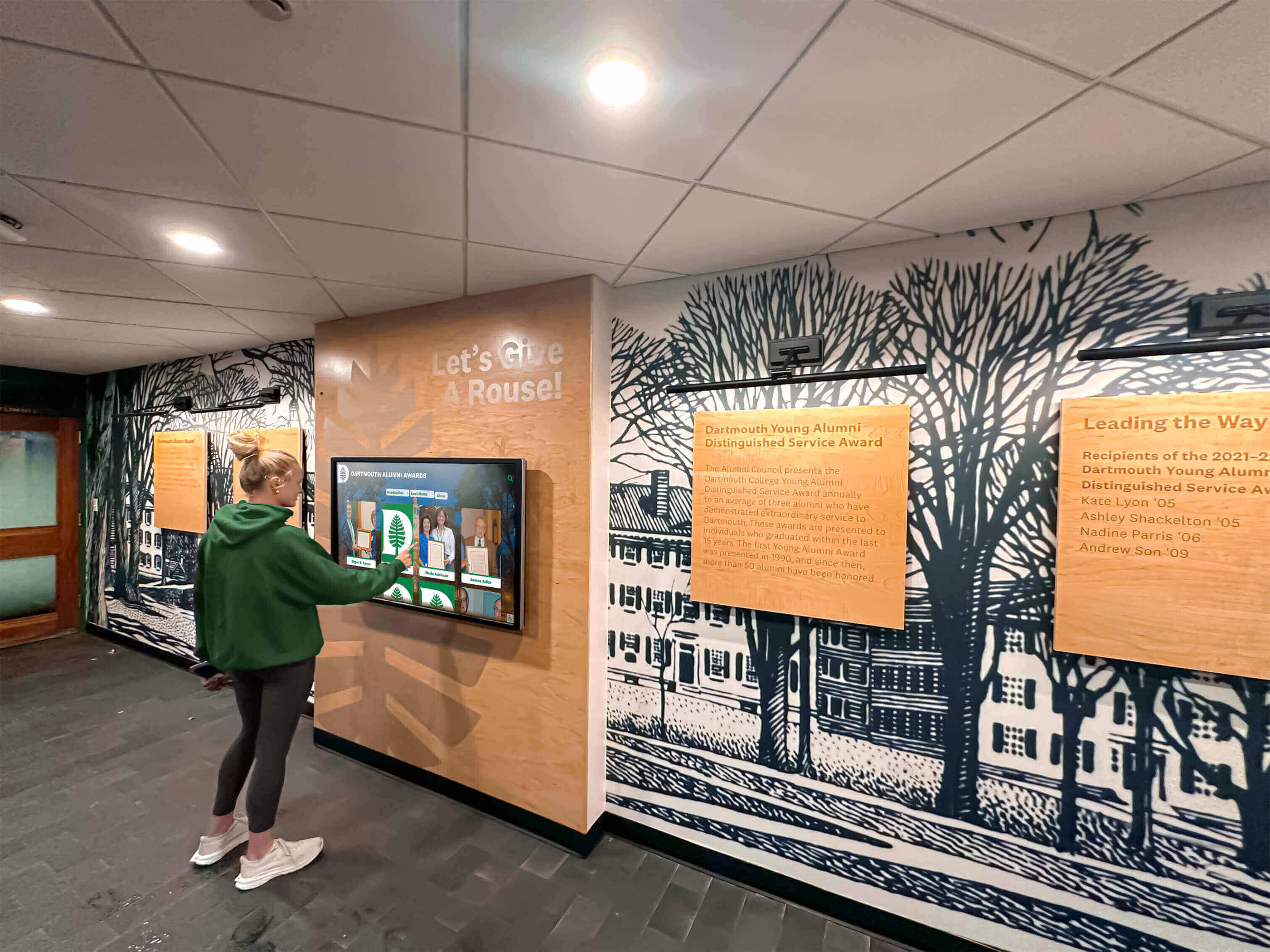
Ready to Transform Your College Placement Recognition?
Explore how Rocket Alumni Solutions can help you create comprehensive systems showcasing where your graduates went to play in college, inspiring future athletes and building lasting athletic traditions. Our digital recognition platforms are designed specifically for high schools, offering intuitive systems making it easy to honor every college-bound athlete with the celebration they deserve.
Visit Rocket Alumni Solutions to discover how modern recognition transforms simple lists of names into engaging experiences that honor the past, celebrate the present, and inspire the future. For additional insights on athletic recognition best practices, explore our guides on college signing wall programs and athletic recruitment strategies.
Contact us today to discuss your vision for celebrating where your graduates went to play in college and discover how the right recognition solution can elevate your athletic program while inspiring the next generation of student-athletes to pursue their own collegiate dreams.
